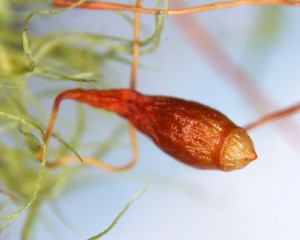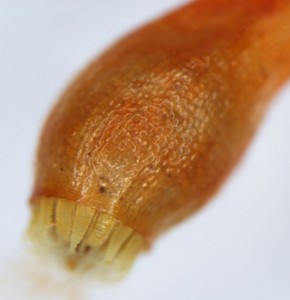Habitat
This species is typically found growing in areas in which the earth has been disturbed. They are especially common in forests that have been burnt. Other natural habitats include cliffs in the forest as well as on logs in shaded areas of the woods. Not only is this plant considered a greenhouse weed, but it is also found in gardens and on concrete walls. The distribution of Leptobryum pyriforme is nearly cosmopolitan, found in all continents other than Antarctica. However, it is more common in climates that are temperate.
Gametophyte
Overall structure:
 These plants, which form loose to dense turfs, are silky, small and their color can range from light green to yellow-green.
These plants, which form loose to dense turfs, are silky, small and their color can range from light green to yellow-green.
Leaves:
 The leaves, which are slender and linear-lanceolate, are slightly contorted and hair-like when dry. However, when they are moist, they become strongly divergent. Furthermore, they typically tend to be clustered near the top of the stem and can be up to 6 mm long. The costa of L. pyriforme is broad and extends to the tip of the leaf, which is toothed at the apex.
The leaves, which are slender and linear-lanceolate, are slightly contorted and hair-like when dry. However, when they are moist, they become strongly divergent. Furthermore, they typically tend to be clustered near the top of the stem and can be up to 6 mm long. The costa of L. pyriforme is broad and extends to the tip of the leaf, which is toothed at the apex.
Leaf cell:
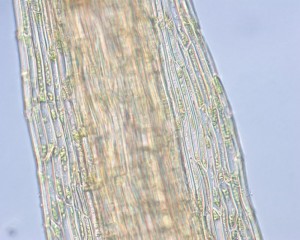 The cells found in the leaves are generally long, smooth and narrow.
The cells found in the leaves are generally long, smooth and narrow.
Stem:
The erect stem, which isn’t usually branched, can reach heights of approximately 1 cm.
Rhizoids:
The dark brown rhizoids of this species can sometimes be visible near the base of the stem, which can be a useful characteristic when trying to identify this species.
Asexual Reproduction:
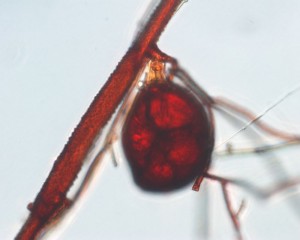 Asexual reproduction is accomplished by the production of tubers, which can occur in abundance. They are typically dark purplish-brown or black in color, club-shaped and can be found on the protonema or the stem.
Asexual reproduction is accomplished by the production of tubers, which can occur in abundance. They are typically dark purplish-brown or black in color, club-shaped and can be found on the protonema or the stem.
Sporophyte
Overall structure:
The sporophytes of this species are common.
Sporangium:
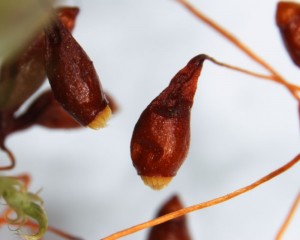 The sporangium of L. pyriforme is shiny and golden-brown in color. Furthermore, it is nodding and pear-shaped, which are distinctive characteristics.
The sporangium of L. pyriforme is shiny and golden-brown in color. Furthermore, it is nodding and pear-shaped, which are distinctive characteristics.
The operculum, when present, is conic in shape.
The peristome teeth are light yellow in color.
Seta:
The seta ranges between 1-3 cm in length and is shiny.
Spores:
The spores of this species are finely papillose.

